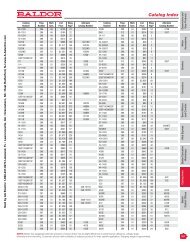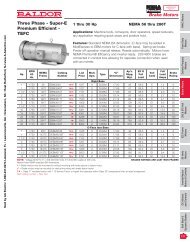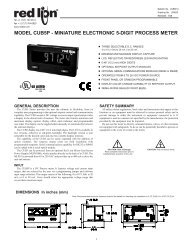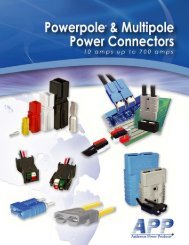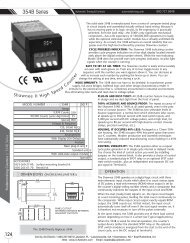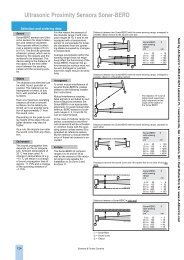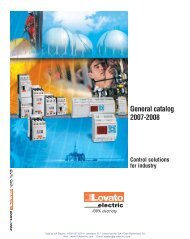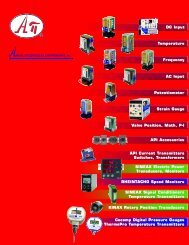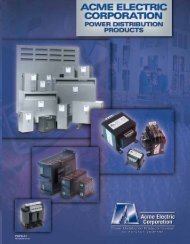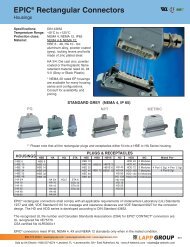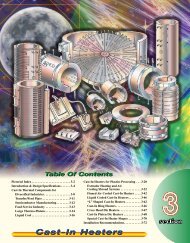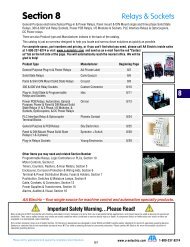- Page 4 and 5: Interface units Weidmüller interfa
- Page 6 and 7: 2 3 1 5 6 4 8 9 7 11 12 10 14 15 13
- Page 8 and 9: Interface units IEC 807-2 Interface
- Page 10 and 11: Supply voltage distributor modules
- Page 12 and 13: ELCO Interface units ELCO Interface
- Page 14 and 15: Card holders Sold by AA Electric 1-
- Page 16 and 17: Card holders 19’’ Euro format S
- Page 18 and 19: Card holders 19’’ Euro format S
- Page 20 and 21: Card holders 19’’ Euro format S
- Page 22 and 23: Card holders 19’’ Euro format S
- Page 24 and 25: Card holders 19’’ Double Euro f
- Page 26 and 27: PLC Interface PLC system interface
- Page 28 and 29: Sold by AA Electric 1-800-237-8274
- Page 30 and 31: PLC Front adapter for SIEMENS S7 So
- Page 32 and 33: PLC Input/output modules Sold by AA
- Page 34 and 35: PLC Input/output modules Sold by AA
- Page 36 and 37: PLC Input/output modules Sold by AA
- Page 38 and 39: PLC Input/output modules Sold by AA
- Page 40 and 41: PLC Input/output modules Sold by AA
- Page 42 and 43: PLC Input/output modules Sold by AA
- Page 44 and 45: PLC Input/output modules Sold by AA
- Page 46 and 47: Control lead Sold by AA Electric 1-
- Page 48 and 49: Power Supplies Sold by AA Electric
- Page 50 and 51: Power supplies Power supplies Sold
- Page 52 and 53:
Power supplies Sold by AA Electric
- Page 54 and 55:
Unregulated power supplies Compact
- Page 56 and 57:
Unregulated power supplies Compact
- Page 58 and 59:
Switch-mode power supplies Connect
- Page 60 and 61:
Switch-mode power supplies Connect
- Page 62 and 63:
Switch-mode power supplies Connect
- Page 64 and 65:
Switch-mode power supplies Connect
- Page 66 and 67:
Switch-mode power supplies Connect
- Page 68 and 69:
Switch-mode power supplies Connect
- Page 70 and 71:
Power supplies Electronic fuse WAVE
- Page 72 and 73:
Fuse for 24Vdc electric circuits WA
- Page 74 and 75:
DC/DC-Converter Connect power CP DC
- Page 76 and 77:
DC/DC-Converter Connect power CP DC
- Page 78 and 79:
Überspannungsschutz Overvoltage pr
- Page 80 and 81:
Overvoltage protection for energy d
- Page 82 and 83:
Overvoltage protection for energy d
- Page 84 and 85:
Overvoltage protection for energy d
- Page 86 and 87:
Overvoltage protection for energy d
- Page 88 and 89:
Overvoltage protection for energy d
- Page 90 and 91:
Overvoltage protection for energy d
- Page 92 and 93:
Overvoltage protection for energy d
- Page 94 and 95:
Sold by AA Electric 1-800-237-8274
- Page 96 and 97:
Overvoltage protection for energy d
- Page 98 and 99:
Overvoltage protection for energy d
- Page 100 and 101:
Sold by AA Electric 1-800-237-8274
- Page 102 and 103:
FAULT 230V~ Overvoltage protection
- Page 104 and 105:
Overvoltage protection for measurem
- Page 106 and 107:
Sold by AA Electric 1-800-237-8274
- Page 108 and 109:
Overvoltage protection for instrume
- Page 110 and 111:
Overvoltage protection for instrume
- Page 112 and 113:
Overvoltage protection for instrume
- Page 114 and 115:
Overvoltage protection for instrume
- Page 116 and 117:
Overvoltage protection for instrume
- Page 118 and 119:
Overvoltage protection for instrume
- Page 120 and 121:
Overvoltage protection for measurem
- Page 122 and 123:
Overvoltage protection for measurem
- Page 124 and 125:
Overvoltage protection for instrume
- Page 126 and 127:
Overvoltage protection for instrume
- Page 128 and 129:
Overvoltage protection for instrume
- Page 130 and 131:
Overvoltage protection for instrume
- Page 132 and 133:
Overvoltage protection for instrume
- Page 134 and 135:
Overvoltage protection for instrume
- Page 136 and 137:
Sold by AA Electric 1-800-237-8274
- Page 138 and 139:
Sold by AA Electric 1-800-237-8274
- Page 140 and 141:
Sold by AA Electric 1-800-237-8274
- Page 142 and 143:
Overvoltage protection for data int
- Page 144 and 145:
Overvoltage protection for data int
- Page 146 and 147:
Overvoltage protection for data int
- Page 148 and 149:
Sold by AA Electric 1-800-237-8274
- Page 150 and 151:
Line Filter Sold by AA Electric 1-8
- Page 152 and 153:
Sold by AA Electric 1-800-237-8274
- Page 154 and 155:
Sold by AA Electric 1-800-237-8274
- Page 156 and 157:
Sold by AA Electric 1-800-237-8274
- Page 158 and 159:
DC/DC passive isolator Input curren
- Page 160 and 161:
DC/DC passive isolator Loop splitte
- Page 162 and 163:
DC/DC 2-way isolator Double sided p
- Page 164 and 165:
DC/DC 3-way isolator 10Hz Cut-off f
- Page 166 and 167:
DC/DC 3-way isolator 10Hz Cut-off f
- Page 168 and 169:
DC/DC 3-way isolator 20kHz Cut-off
- Page 170 and 171:
DC/DC 3-way isolator 20kHz Cut-off
- Page 172 and 173:
DC/DC 3-way isolator Configurable D
- Page 174 and 175:
Supply isolator With HART MAS RPSH
- Page 176 and 177:
PT100 / RTD - signal isolator/conve
- Page 178 and 179:
PT100 / RTD - signal isolator/conve
- Page 180 and 181:
PT100 / RTD - signal isolator/conve
- Page 182 and 183:
PT100 / RTD - signal isolator/conve
- Page 184 and 185:
Thermo element, signal isolator/con
- Page 186 and 187:
Thermo element, signal isolator/con
- Page 188 and 189:
Sold by AA Electric 1-800-237-8274
- Page 190 and 191:
Frequency signal transformer WAVEAN
- Page 192 and 193:
Sold by AA Electric 1-800-237-8274
- Page 194 and 195:
Serial interface converter Sold by
- Page 196 and 197:
AD-/DA-Converter Sold by AA Electri
- Page 198 and 199:
AD-/DA-Converter Sold by AA Electri
- Page 200 and 201:
AD-/DA-Converter Sold by AA Electri
- Page 202 and 203:
AD-/DA-Converter Sold by AA Electri
- Page 204 and 205:
Sold by AA Electric 1-800-237-8274
- Page 206 and 207:
Preprocessing logic Preprocessing l
- Page 208 and 209:
Preprocessing logic Preprocessing l
- Page 210 and 211:
Monitoring modules Sold by AA Elect
- Page 212 and 213:
Current monitoring Sold by AA Elect
- Page 214 and 215:
Current monitoring Sold by AA Elect
- Page 216 and 217:
Voltage monitoring Sold by AA Elect
- Page 218 and 219:
Threshold monitoring Sold by AA Ele
- Page 220 and 221:
Accessories WAVEBOX S 22,5 WAVEBOX
- Page 222 and 223:
Digital signal processing Sold by A
- Page 224 and 225:
Relay coupler - overview Contact ty
- Page 226 and 227:
Relay coupler - overview Definition
- Page 228 and 229:
Relay coupler - overview Enclosure
- Page 230 and 231:
PLUGSERIES 1 change-over contact So
- Page 232 and 233:
PLUGSERIES 2 change-over contacts S
- Page 234 and 235:
Sold by AA Electric 1-800-237-8274
- Page 236 and 237:
PLUGSERIES Relay on plug-in base Sc
- Page 238 and 239:
PLUGINDUSTRY Miniature power relay
- Page 240 and 241:
Sold by AA Electric 1-800-237-8274
- Page 242 and 243:
MICROSERIES 1 change-over contact S
- Page 244 and 245:
MICROSERIES Accessories General dat
- Page 246 and 247:
WAVESERIES 1 change-over contact So
- Page 248 and 249:
[ [ WAVESERIES 1 NC contact / 1 NO
- Page 250 and 251:
[ [ WAVESERIES 3 NO contacts Sold b
- Page 252 and 253:
RS-SERIES - RS 30 RS 30 Screw conne
- Page 254 and 255:
RS-SERIES - RS 31 1 change-over con
- Page 256 and 257:
RS-SERIES - RS 32 2 change over con
- Page 258 and 259:
Sold by AA Electric 1-800-237-8274
- Page 260 and 261:
RS-SERIES - with RSM multiple inter
- Page 262 and 263:
MCZ-Series MiniConditioner MCZ R So
- Page 264 and 265:
DK-SERIES 1 NO contact, input top S
- Page 266 and 267:
Sold by AA Electric 1-800-237-8274
- Page 268 and 269:
EG SERIES 1 NOC, 1 NCC, 1 change-ov
- Page 270 and 271:
Optocoupler - Overview Our highligh
- Page 272 and 273:
Optocoupler - Overview Optocoupler
- Page 274 and 275:
Optocoupler - Overview Enclosure ty
- Page 276 and 277:
PLUGSERIES Output current 24 Vdc /
- Page 278 and 279:
PLUGSERIES Output current 230 Vac /
- Page 280 and 281:
PLUGSERIES Accessories Schrack RP3S
- Page 282 and 283:
MICROSERIES Output current 24 Vdc /
- Page 284 and 285:
MICROSERIES Accessories General dat
- Page 286 and 287:
WAVESERIES Output voltage 5-48 Vdc
- Page 288 and 289:
[ [ WAVESERIES Output voltage 24 Vd
- Page 290 and 291:
WAVESERIES Output volt. 24 Vdc, 0.5
- Page 292 and 293:
Sold by AA Electric 1-800-237-8274
- Page 294 and 295:
MCZ-SERIES MiniConditioner MCZ O 12
- Page 296 and 297:
Sold by AA Electric 1-800-237-8274
- Page 298 and 299:
DK-SERIES Minicoupler DKO 24VUC 24V
- Page 300 and 301:
DK-SERIES Minicoupler DKO 24VDC 200
- Page 302 and 303:
Sold by AA Electric 1-800-237-8274
- Page 304 and 305:
EG-SERIES EG 7 48VUC 115VUC 230VAC
- Page 306 and 307:
Sold by AA Electric 1-800-237-8274
- Page 308 and 309:
BT-SERIES Sold by AA Electric 1-800
- Page 310 and 311:
BT-SERIES Multi-function relay with
- Page 312 and 313:
BT-SERIES Time relay (BTTT) Time re
- Page 314 and 315:
DK-SERIES Minicoupler DKZ 24VDC 10-
- Page 316 and 317:
MCZ-SERIES Miniconditioner MCZ TO 2
- Page 318 and 319:
Overview Sold by AA Electric 1-800-
- Page 320 and 321:
Rectifier modules EGD 1 EGD 2 Sold
- Page 322 and 323:
Rectifier modules RSX RSX-ADP Sold
- Page 324 and 325:
Uin 24 V IN P Uout 24 V 0,2A Uin 24



